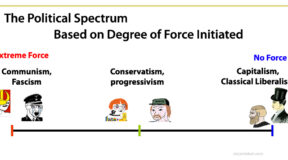
In the “What market failure” we will look at the various claims that the free market failed, and show that the principles of the free market did not fail, but where coercively distorted by government intervention.
Claim: In the current financial crisis, banks didn’t have enough capital, and could not recapitalize them selves on the free market. The free market failed, thus the 750 billion TARP program(government loans) had to be passed.
Example Paraphrased from John Allison.
The market did not fail? What happened is government intervention and regulation in the market caused market distortions. Here is a simple example of one govenrment induced distortion. We do not have a free market accounting practices. Accounting practices are set by the Security Exchange Commission(SEC). The SEC set the accounting practices to fair value accounting, or market to market accounting. And that is what created a distortion. Lets say there was a mortgage bond worth $100million in the market. But because mortgages that were not being paid under the bond, and people expected not to pay in the future, economically the bond is worth 80million, and thats what it should of sold for. But because of the panic in the market the only buyers where deep discounters, who would only pay $50million. This has big implications because under fair value accounting the financial institution, instead of marking down the bond $20million had to mark it down $50million. With banks being leverage at least 10 to 1, instead of $200million of lending capacity being destroyed, $500million was destroyed just because of accounting system. So why didn’t the market correct that? There were banks with money that saw that the bond was worth $80million could of went in and bought the bond for $50million, and with banks competing for the price, the price would of got close to $80million. But the banks didn’t do that because they where afraid of the accounting risk. They would not even buy it for 50million because under this panic market, under fair value accounting the bond could be worth$ 40million next quarter, and they would have to take a mark down. Fair value accounting created a market distortion by adding an accounting risk, that would never have existed under a free market.





2 Comments
What market failure? Final Part. Lets Review. – objectobot.com
(May 30, 2024 - 8:48 pm)[…] sets the accounting rules to something called market-to-market or fair value accounting. (See Part1). This means that, even if a borrower can pay the mortgage, and if these mortgage-backed […]
Dr. Doom
(December 2, 2024 - 12:22 am)This argument misrepresents the causes of the financial crisis and the role of mark-to-market (MTM) accounting. Here’s why:
1. Mark-to-Market Accounting Didn’t Create the Crisis: MTM reflected the reality of collapsing asset values during the financial panic. The real issue was the underlying poor-quality loans bundled into securities, not the accounting rules.
2. Banks’ Inaction: The claim that banks avoided buying underpriced assets due to MTM risk overlooks the primary reason—they lacked trust in counterparties and liquidity due to systemic uncertainty.
3. Broader Context Ignored: The crisis was caused by excessive leverage, poor risk management, and unregulated derivatives markets, not solely MTM accounting.
Blaming MTM oversimplifies the systemic issues driving the crisis.